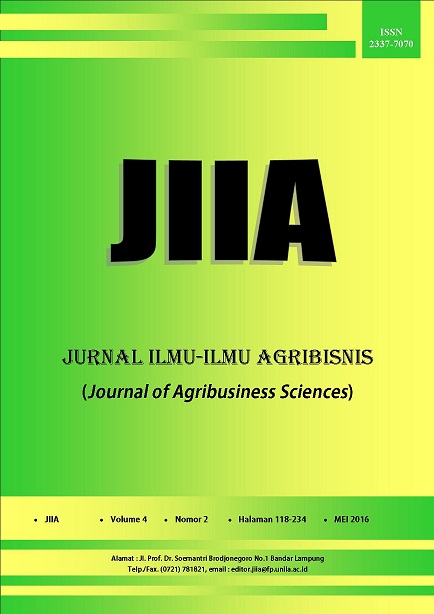PREFERENSI DAN PERMINTAAN KONSUMEN RUMAH TANGGA TERHADAP BIHUN TAPIOKA DI KECAMATAN PURBOLINGGO KABUPATEN LAMPUNG TIMUR
DOI:
https://doi.org/10.23960/jiia.v4i2.1238 Abstract View: 479
Abstract View: 479
Abstract
This research’s aims to determine the preferences, demand pattern and the factors which affect households demand for tapioca vermicelli in District of Purbolinggo of East Lampung Regency. This research was conducted by survey method. The research location is determined on purpose which is in District of Purbolinggo East Lampung Regency. This research was conducted in the markets and stalls around the house in District of Purbolinggo. There were 60 respondents household vermicelli tapioca in this study that was taken by accidental sampling. The data collection was carried out in June-September 2015. The method of analysis used in this study was quantitative descriptive to determine the preferences of households against tapioca vermicelli and the method with multiple linear regression method was used to determine the factors which affected households’ demand for tapioca vermicelli in District of Purbolinggo. The results showed that consumer preferences of households in the district of Purbolinggo against tapioca noodles are in the like category. The average purchase tapioca noodles was as much as 1.36 kg/month/household, the average frequency of purchase tapioca noodles was twice in a month, tapioca vermicelli widely used by domestic consumers as a soup, as well as the brand more preferred and purchased by domestic consumers are brand Moroseneng, consumers prefer or choose where to buy tapioca vermicelli that is in the shop , both at home and at stalls around the market. The demand vermicelli tapioca by consumer households in the District Purbolinggo East Lampung regency is influenced by the price of tapioca vermicelli, noodles prices, income, number or family members, ethnicity, primary school education and secondary education.
Key words: demand, preferences,tapioca vermicelli
Downloads
Downloads
Published
How to Cite
Issue
Section
License
Authors who publish with this journal agree to the following terms:
Authors retain copyright and grant the journal right of first publication with the work simultaneously licensed under a Creative Commons Attribution License that allows others to share the work with an acknowledgement of the work's authorship and initial publication in this journal.
Authors are able to enter into separate, additional contractual arrangements for the non-exclusive distribution of the journal's published version of the work (e.g., post it to an institutional repository or publish it in a book), with an acknowledgement of its initial publication in this journal.
Authors are permitted and encouraged to post their work online (e.g., in institutional repositories or on their website) prior to and during the submission process, as it can lead to productive exchanges, as well as earlier and greater citation of published work (See The Effect of Open Access).














